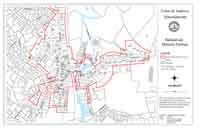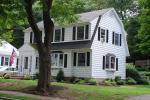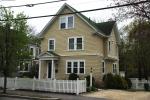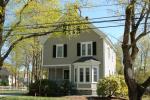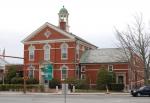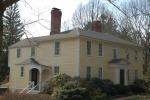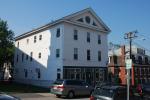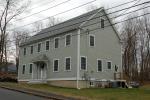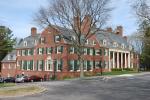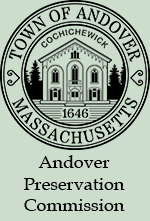The BallardVale Historic District was established by the Town of Andover in 1995 with the intent to preserve the significant, distinctive architecture and rich character left to us by the 19th and 20th century residents of BallardVale. It is administered by a Commission that reviews all proposed exterior changes to buildings located in the district.
Property Listing (pdf 22k)
Local Historic Districts in Massachusetts
Local Historic Districts have three major purposes as stated in Chapter 40C of the Massachusetts General Laws.
- To preserve and protect the distinctive characteristics of the buildings and places significant to the history of the Commonwealth’s cities and towns.
- To maintain and improve the settings of those buildings and places.
- To encourage compatibility with existing buildings when new buildings are planned within the district.
some historic houses in the BallardVale Historic District
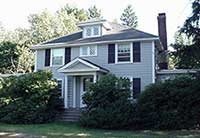
235 Andover Street
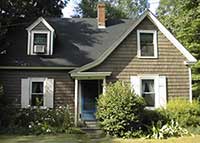
33 Tewksbury Street
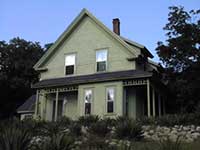
15 Clark Road
Historic District Commissions do not prevent changes from occurring, nor do they prevent new construction. Their purpose is to ensure that changes and additions are harmonious, and to prevent changes that might detract from the aesthetic and historic values of the district. The commission does not halt growth, but allows for careful consideration of change. A local historic district is not meant to be burdensome to property owners, but is established to administer change and enhance the value of the district.
The BallardVale Historic District Commission (BVHDC)
The Commission consists of seven members and two alternates, appointed by the Town Manager and approved by the Board of Selectmen, to a term of three years. The Commission shall include, when possible, representatives from the following groups: Andover Preservation Commission; Andover Historical Society; Greater Lawrence Board of Realtors; Andover Planning Board; BallardVale business community; a resident/owner of property in the district, and a registered architect. If possible all members shall be resident/owners in the district. The Commission, under a specific set of regulations and guidelines, deals with exterior architectural changes. The Commission is required by law to review the appropriateness of most exterior design changes, additions, new construction and demolition.
Current BallardVale Historic District Commission Members (December 2025):
- Joanna Reck, Chair
- Mark Rogers, Vice Chair
- Elisabeth Hoehn, Clerk
- Sabina Dowell
- Remi Machet
- Katherine Robinson
- Alexis Winnell
- Veena Kothapalli (Alternate)
The Application/Review Process
Please visit the Ballardvale Historic District Commission webpage for information on the application/review process.
The BallardVale Gazette
The BallardVale Gazette is a newsletter of the BallardVale Historic Distsrict Commission and is published 2-3 times per year. It is mailed or emailed to each property owner in the District, as well as to town officials, town departments and anyone who has notified the Editor of their desire to be on the mailing list.
Recent editions of the Gazette are listed below and links are provided.
- Fall/Winter 2025
- Spring/Summer 2025
- Fall/Winter 2024
- Spring/Summer 2024
- Fall/Winter 2023
- Spring/Summer 2023
- Fall/Winter 2022
- Spring/Summer 2022
- Fall/Winter 2021
- Spring/Summer 2021
- Fall/Winter 2020
- Spring/Summer 2020
- Spring/Summer 2019
- Fall/Winter 2018
- Spring/Summer 2018
- Summer/Fall 2017
- Fall 2016
- Spring 2016
- Fall 2015
- Spring 2015
- Fall 2014
- Block Party Flyer 2011
- November 2010
- August 2010
- March 2010
- November 2009
- March 2009
- November 2008
- August 2008
- March 2008
- August 2007
- November 2006
- April 2006
- August 2005
- March 2005
- November 2004
- July 2004
- March 2004
- November 2003
- June 2003
- March 2003
- November 2002
- July 2002
- March 2002
- November 2001
- August 2001
- July 2001
- Summer 1986
- November 1985
History of BallardVale

the mill at 204 Andover Street
The BallardVale Historic District encompasses a tightly knit, though highly diverse community that has significantly retained its 19th century characteristics. BallardVale, the first of Andover’s planned mill villages, is located on the banks of the Shawsheen River. Water power was first harnessed by Timothy Ballard, who operated grist and saw mills, and then by the BallardVale Manufacturing Company that built a 200-foot long dam.
The Historic District boundaries circle central BallardVale, with Andover Street as the main street and Center, Marland, Dale and High Streets laid out with comfortable house lots in an 1848 subdivision. Portions of High Vale Lane, Chester, Oak and Tewksbury Streets and Clark Road are included. The original BallardVale Manufacturing Company (est. 1836) sits on the Shawsheen River and is a four-story brick structure with granite trim and a gable roof.
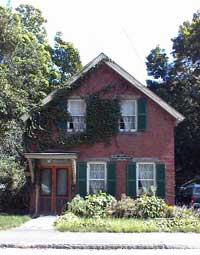
8 Marland Street
The early employees of the factories were skilled Scotch, English, Irish and German craftsmen. The mills become world renowned, producing flannels, worsted goods and delaines. Other industries that operated in the center of the village included the BallardVale Machine Shop Company (est. 1848), which manufactured locomotives; Whipple File Company (est. 1860), the world’s first firm to machine cut files successfully; Abbot Hat Factory; Craighead and Kintz (est. 1883), which produced “art” metalwork lamps, plaques and figures; and the Willard and BallardVale Potteries. By the 1860s, BallardVale bustled with industrial and commercial activities supported by the railroad depot, post office, millinery shop, shoe shops, poolroom, barbershop, bowling alley, tailor, blacksmith, tavern and several general stores. Andover’s first public library, two churches and an entertainment hall contributed to the cultural life of the villagers.
Single, multi-family and boarding houses were built in the popular styles of the time. The buildings at 6–8 Dale and 21 Tewksbury Streets represent the Greek Revival style, although the former is a brick duplex and the latter a wooden cottage. The picturesque Gothic Revival style is depicted at both 14 High Vale Lane and 51 Center Street, whereas 174–176 Andover Street (formerly the railroad depot) and 228 Andover Street illustrate Italianate architecture. BallardVale was added to the National Register of Historic Districts in 1987.
